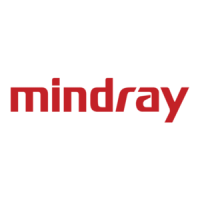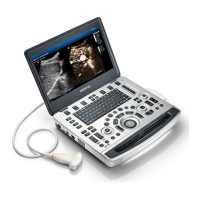6 - 32 Operator’s Manual
6 Image Acquisition
2. Tap [Tissue Tracking QA] or press the user-defined key to activate the function:
– You can determine the image of interest by previewing the image.
– Use [Cycle] to select and find the image of interest.
3. Select the corresponding section name and locate one frame image with good image effect by
cine play. Use the cursor to set the reference point:
– Long axis section: use the “3-point” method or “Manual” method to set.
– Short axis section: enter multiple points (at least 6 points) using the cursor manually to
set.
4. After reference points are set, the system will display the boundary of the endocardium and
epicardium. Adjust the thickness if necessary.
If the traced result is poor, tap [Reload] to re-trace the reference points, or make fine
adjustments to the points using the cursor.
If the cycles are not adequate to provide the information, switch to another cycle to trace.
5. Tap [Start Tracking] on the soft menu to start the tracking function. Adjust the parameters if
necessary.
Tap [Edit] on the soft menu to display the cursor. Use the trackball and press <Set> to re-select
the trace reference points (inner dots of the curve). Move the cursor to the exact boundary
position and press <Set> again to set the right place. Tap [Start Tracking] to start tracking
again.
6. Tap [Accept & Compute] to calculate and display the curve.
Adjust the parameters if necessary.
7. Tap [Bull's Eye] to see the result.
8. If necessary, press <Save+> key to save the result.
9. If necessary, repeat steps 3-8 to track the next section.
NOTE:
The screen displays the result of the current section, and the bull’s eye graph shows the
average value of all the tracked sections.
10. Tap [Data Export] to export analyzed data.
11. Tap [Exit] to exit.

